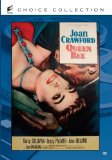| Reviews & Columns |
|
Reviews DVD TV on DVD Blu-ray 4K UHD International DVDs In Theaters Reviews by Studio Video Games Features Collector Series DVDs Easter Egg Database Interviews DVD Talk Radio Feature Articles Columns Anime Talk DVD Savant Horror DVDs The M.O.D. Squad Art House HD Talk Silent DVD
|
DVD Talk Forum |
|
|
| Resources |
|
DVD Price Search Customer Service #'s RCE Info Links |
|
Columns
|
|
|
Queen Bee (Sony Choice Collection)
"It makes me terribly cross when people oppose me."
Deliciously overripe meller, thanks to some cruel, snappy wit and Joan Crawford's otherworldly, hypnotic turn. Sony Pictures' Choice Collection line of hard-to-find library, foreign, and cult titles has released Queen Bee, the 1955 melodrama from Columbia Pictures starring Joan Crawford, Barry Sullivan, Betsy Palmer, John Ireland, Lucy Marlow, William Leslie, and Fay Wray. Glossily produced by Jerry Wald and written and directed by Ranald MacDougall, Queen Bee may not be terribly original in terms of its plotting, nor is it as subtextually rewarding as Crawford's earlier, similar drama, Harriet Craig. However, Queen Bee packs an entertaining wallop due to its humorously bitchy tone, its smooth, assured pacing, and the superlatively menacing performance from its lead, Joan Crawford. A must-see for fans of the star and of the genre. Nothing new here for buyers who already possess one of the previous DVD releases of Queen Bee--that means no extras for this sharp black and white anamorphically enhanced widescreen transfer.
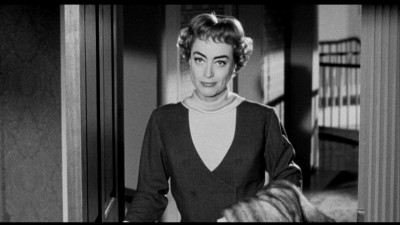
Chicago native and orphaned poor relation Jennifer Stewart (Lucy Marlow) has arrived down South to live with her cousin, Eva Phillips (Joan Crawford), the imposing matriarch of the proud, wealthy mill-owning Phillips family. While Jennifer is in awe of her successful, generous, and seemingly kind cousin, everyone else in the expansive mansion warns the naive Jennifer to watch her step with the calculating, treacherous Eva. Eva's husband, Avery (Barry Sullivan), nicknamed "Beauty" for the nasty scar on his face, is a weak-willed, depressive drunk who barely conceals his hatred for his beautiful, controlling wife. Avery's sister, Carol (Betsy Palmer), despises Eva, as well, particularly since Eva's, um...influence, has crossed over to Carol's secret fiance, Judson Prentiss (John Ireland), the general manager of the Phillips' mills, and a former (and soon future?) lover of the married Eva. Neighbor Ty McKinnon (William Leslie) knows full-well the manipulative power of Eva, as does, unfortunately, his sister, Sue McKinnon (Fay Wray), a faded Southern belle driven slightly mad by former fiance Avery's abandoning her at the altar...for Yankee interloper Eva. Even Eva's children are leery of their cold, threatening mother; with Trissa (Linda Bennett) and particularly disturbed Ted Phillips (Tim Hovey), considering loving Aunt Carol more of a mother than distant, uninvolved Eva. When the family's secrets begin to unravel in front of Jennifer, and Carol's and Jud's marriage plans are made public, a series of destructive countermeasures are implemented by the scheming Eva...with deadly results.
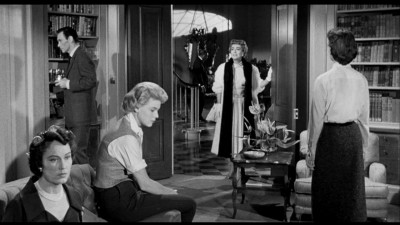
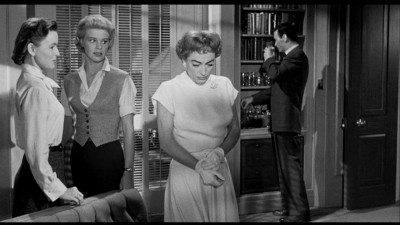
By the November, 1955 release of Columbia's Queen Bee, Joan Crawford was in the midst of her third successful career comeback. In the mid-1920s, having puckishly created her own publicity to force an uninterested MGM into moving her up from anonymous contract player to leading actress status, the fiercely determined Crawford rode out the next 18 years at Metro, becoming one of the studio's top female attractions, graduating from flapper musicals like Our Dancing Daughters and Our Modern Maidens, to high-ticket mellers and romances like Possessed, Grand Hotel, Rain, and Chained. With Depression-era audiences for Crawford pictures gradually dwindling as the 30s wore on, Crawford and several other big stars were notoriously labeled "box office poison" by the Independent Film Journal in 1938 (a move many saw as the studios' way of "helping along" the removal of overpaid, under-attended stars). As Crawford's salary went up, ticket sales went down, and she was eventually let go by M-G-M's Louis B. Mayer in 1943. A move to the harder-edged, less glamorous, faster-paced Warner Bros. studio that same year eventually led to a lucky career break when arch rival Bette Davis foolishly passed on 1945's smash hit, Mildred Pierce; the role gave Crawford her only Best Actress Oscar, and led to string of highly-publicized successes, including Humoresque, Possessed, Daisy Kenyon, Flamingo Road, and The Damned Don't Cry!. Soon after 1952's critically lambasted misfire, This Woman is Dangerous, though, Crawford terminated her Warner's contract and freelanced, landing a popular hit that same year with the RKO noir, Sudden Fear, a movie that rejuvenated her career just as Mildred Pierce previously did, resulting in one-offs for Metro (Torch Song), Republic Pictures (the cult classic, Johnny Guitar), Universal (Female on the Beach), and a return to Columbia (1950's Harriet Craig) for a three picture deal, commencing with the financially successful Queen Bee (to be followed by Robert Aldrich's Autumn Leaves in 1956, and The Story of Esther Costello in 1957).
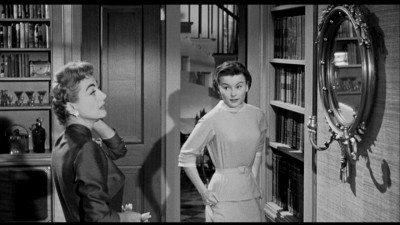
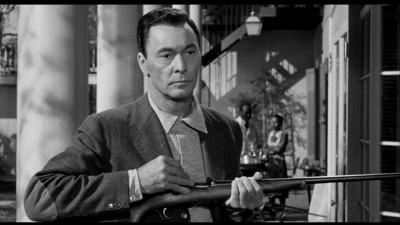
As I wrote in my review of Harriet Craig, since Crawford's legacy is now (fairly or unfairly) inextricably tied-in with the literary and subsequent cinematic portrait drawn from her adopted daughter Christina's excoriating tell-all, Mommie Dearest, it's difficult not to watch Crawford's outsized melodramas like Queen Bee and subsequently look upon the lead characters as almost backwards incarnations of our own perceptions of who and what Joan Crawford was off-screen--a weird, self-reflexive exercise that only makes these overheated Crawford mellers all that much more perversely enjoyable. Apparently, Christina Crawford specifically cited Queen Bee's venomously manipulative Eva Phillips as the screen incarnation closest to her mother's real-life off-camera persona. Whether or not that's true is subject to debate (posthumously, Crawford had her detractors and supporters variously support and reject Christina's assertions), but even the suggestion of such a "real/reel" link provides the Queen Bee viewer with an added layer of delightfully morbid curiosity.
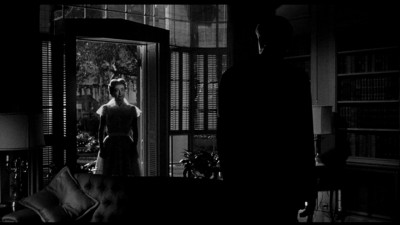
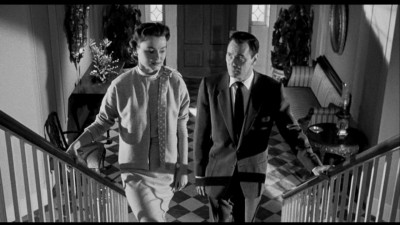
Queen Bee doesn't offer the same opportunities for rich sociological/gender subtextual readings compared to the surprisingly similar (in structure and narrative framework) Harriet Craig, a cold, calculated bit of domestic hysteria; a totalitarian sick joke on the emerging 1950s "wife/mother knows best" myth. Queen Bee is a far more conventional, "straight-ahead" melodrama than Harriet Craig (the title Queen Bee doesn't leave any room for doubt over the movie's intention), overheated not by a particularly informed visual schematic, but by lurid, bitchy dialogue and a lead performer almost supernaturally attuned to the vehicle's possibilities for carefully-controlled grotesquerie (and when factoring in those pungent qualities, Queen Bee comes off as more overtly, viscerally entertaining than the chilly Harriet Craig. Script writer Ranald MacDougall (Mildred Pierce, Possessed, Mr. Belvedere Rings the Bell) is far better at creating a verbal portrait of a monstrously-controlled and controlling, viciously-tongued, rotted-out manipulator in Crawford's Eva, than Ranald MacDougall the director (The Subterraneans, Go Naked in the World, The Cockeyed Cowboys of Calico County) is in visually creating, let alone commenting on, the mise-en-scene of this twisted psychological universe of the Phillips' house (cinematographer Charles Lang's lighting may be superficially enticing, but MacDougall blandly frames everything for television, it seems). MacDougall's script admirably sets up a mood of uneasiness right from the opening scene, where a tentative, scared Jennifer looks as if she's ready to run before knocking at the front door of the expansive Phillips' mansion. Once we're inside, that apprehension never lets up, with the dialogue cleverly foreshadowing the unseen Eva as a figure of almost epic dread (fueled by our own perceptions of over-the-top Crawford) before Crawford ever graces the screen. Once she does, Crawford's Eva commands it, first with a delicate, subtle control over MacDougall's brittlely polite conversation, evolving into an openly poisonous, dictatorial demeanor that demands her character's utter destruction.
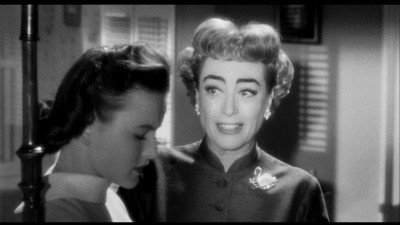
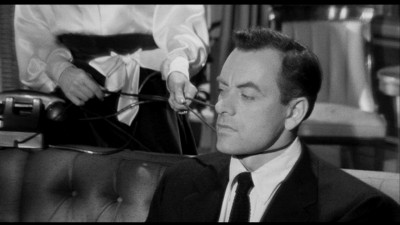
Crawford's performance here in Queen Bee is one of her best. Most critics remark on Crawford's capacity here to starkly delineate complete, vile, manipulative evilness in her Eva, which is quite true. However, they frequently fail to mention Crawford's careful attention to showing how Eva has been hurt by her victims. As in her other "monster" roles, Crawford, quite brilliantly, is able to somehow make us feel, if certainly not "forgiveness," then at least "pity," in this case for Eva, despite the terrible things she does to her family. When we first see Crawford stride into the mansion, everyone gathered together suddenly goes quiet, deliberately looking away from her, which Crawford registers with a look of pained rejection. Later, she tells Jennifer how she was treated when she came down South, with the various close-knit clans utterly rejecting her (one wonders if Crawford drew on her own real-life experiences of being rejected by Hollywood "royalty" Douglas Fairbanks, Sr. and Mary Pickford, when she married their son, Douglas Fairbanks, Jr., against their wishes). Of course Eva is completely unbalanced and disturbed, believing others are responsible for how she ultimately acts ("You don't know the things they made me do trying to protect myself," she appeals to Jennifer, in the movie's most tantalizingly vague line), but Crawford is able to elicit something close to sympathy in these moments--a shading of her character that only serves to sadly underline those other moments of Eva's abject cruelty and manipulation. Committing 100% as she always did with her roles, no matter the project's worth, Crawford runs the gamut here from patronizingly indulgent (her seemingly "kind" treatment of Jennifer-as-secretary), to uber-confident man-eater ("Any man is my man if I want it that way,"), to eroticized dominatrix (you won't see many other potent fetishistic shots in a typical 50s meller like the one here where a turned-on Crawford slings a telephone cord menacingly around Ireland's neck), to horrified self-realization of her own sickness (SPOILER ALERT her genuine shock and revulsion at discovering her manipulative games have led to Carol's suicide, leading Crawford to scream over and over again, smearing her cold cream on her vanity mirror to obscure--whitewash--her own image). It's a remarkable performance by Joan Crawford, beautifully modulated even in its more oversized moments, in a not too terribly deep, but nonetheless deeply satisfying, melodrama.
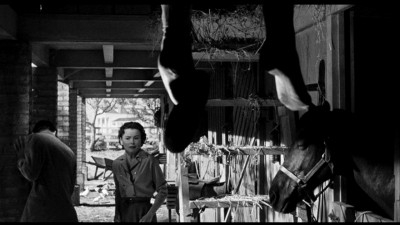
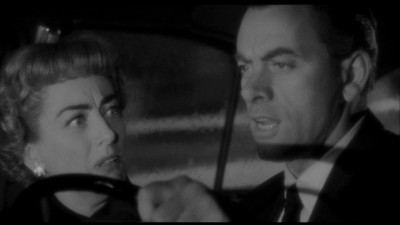
The DVD:
The Video:
The anamorphically-enhanced, 1.85:1 widescreen black and white transfer for Queen Bee looks quite good, with sharp detail, solid blacks, no wonky contrast, and fine grain. Few if any screen imperfections. Very nice.
The Audio:
The Dolby Digital English mono audio track has very little discernable hiss, with a solid re-recording level. No subtitles or closed-captions.
The Extras:
Unlike the two previous releases of this title, there are no extras for Queen Bee...not even a menu.
Final Thoughts:
Lurid, wonderfully satisfying melodrama dressed up like chic Southern Gothic. Ranald MacDougall writes better than he directs here, giving little in the way of visual commentary on his familiar but witty, wicked script. Luckily, Joan Crawford gives a performance of remarkable artistry--one of her best out of countless excellent turns--shading her ghastly manipulator Eve with just the barest suggestion of pity...just enough to make us understand all that delicious sadism. I'm highly, highly recommending Queen Bee.
Paul Mavis is an internationally published movie and television historian, a member of the Online Film Critics Society, and the author of The Espionage Filmography.


|
| Popular Reviews |
| Sponsored Links |
|
|
| Sponsored Links |
|
|
| Release List | Reviews | Shop | Newsletter | Forum | DVD Giveaways | Blu-Ray | Advertise |
|
Copyright 2024 DVDTalk.com All Rights Reserved. Legal Info, Privacy Policy, Terms of Use,
Manage Preferences,
Your Privacy Choices | |||||||









